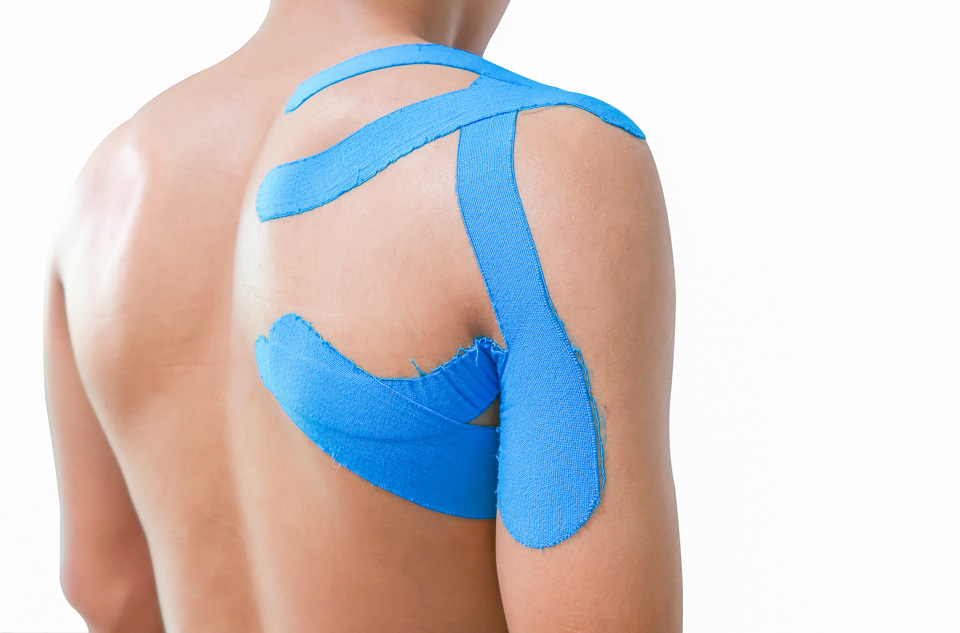
Kinesiology taping (kinesiotaping) is a treatment option if you've had an injury or illness that leads to mobility and motor function problems. It involves placing strips of special tape on your body in specific directions to help support your joints, like a knee, ankle, or wrist, as well as muscles and tendons. It can be used to help facilitate muscle function, stabilize joints, or inhibit muscles from contracting improperly. It can also be used to help decrease pain, swelling, and muscle spasm.
How Kinesiology Tape Works
Kinesiology tape serves different functions when applied. Before you start using it, your physical therapist will perform an evaluation and assessment to determine the best use of kinesiology tape for your condition. They will assess whether the tape is necessary for you or if you have any contraindications to using the tape. In general, it is thought that kinesiology tape helps to create balance in the neural circuitry in muscles, tendons, joints, and skin. This is thought to work to reduce pain and decrease swelling. It's meant to improve muscle performance and function.
Kinesiology tape is also thought to realign joint positions, and it may also be useful in remodeling collagen tissues such as in scar tissue management.
There are different theories about how kinesiology tape works. First, it is thought to change the proprioception input of the sensory nervous system in the muscles, joints, and skin. This is the sensation that allows you to know where your body is in space (say, how high your arm is raised).3
The tape is thought to improve the interaction between the skin and the underlying structures to help reset the circuitry of this part of the nervous system, resulting in improved muscular activation and performance. Kinesiology tape is also thought to inhibit nociceptors (pain pathways) in your muscles, skin, and joint structures.4 Decreasing painful input to the brain is thought to normalize muscle tone, resulting in decreased pain and muscular spasm.
Types of Kinesiology Tape
Kinesiology tape can be applied in different ways, depending on why it's needed. Your physical therapist can show you how to use the tape and cut the adhesive strips into the right configuration.
Some of the taping (kinesiotaping) types include:
The "I" strip: This shape can be used to make the other types of strips below. Typically "I" strips are used to support muscles, tendons, and ligaments. They are often used to facilitate your rotator cuff, gluteus muscles, quadriceps, or Achilles' tendon.5 It can also be used on your low back and middle back to help you maintain proper posture.
The "X" strip: This type is used when kinesiology tape is needed to cover a large area or cross multiple joints. The tabs of the "X" strip cross over sensitive areas such as the back of your knees or front of your elbows. This strip is commonly used to facilitate your hamstrings, which cross both your hip joint and the back part of your knee joint.
The "Y" strip: This strip is used to cross sensitive areas of your body such as behind your knee or in the front of your elbow. It is also commonly used for applications to control the position of your kneecap as in patellofemoral stress syndrome or a subluxing patella. The "Y" strip is typically not as long as the "X" strip.
The "fan" strip: This type can help control swelling of your leg or arm. It is commonly used in lymphedema management or for superficial contusions and swelling.
The "lift" strip: Commonly referred to as the Band-Aid, this strip is often used to support injured tissues or to treat muscle knots or trigger points. It helps to lift skin and tissues off of sore muscles and trigger points. It is also used to treat superficial bruises.
Research on Kinesiology Tape
Much research still needs to be done to understand the mechanisms of how the tape works and if it truly lives up to its claims. Recent studies have shown that the use of kinesiology tape can improve muscular contractions in the vastus medialis, a specific part of the quadriceps muscle responsible for controlling the position of your kneecap. They've also demonstrated an improved range of motion in the lower back, immediately after the application of kinesiology tape.
To support the use of kinesiology tape to improve athletic performance, RockTape conducted a study of five cyclists and found that they performed 2% to 6% better with the application of kinesiology tape than without the tape. However, this study may be biased, with RockTape as its sponsor and only five athletes with no control group. Other studies have examined the effect of kinesiology taping and pain, swelling, and improved mobility, with varied results.
Your physical therapist may use various exercises and modalities to help treat your specific problem. Kinesiology tape may be a part of your treatment. Talk to your provider to learn about the tape and set realistic goals for its use.
#kinesiotaping, #taping, #tapes, #physical therapist.
https://www.verywellhealth.com/kinesiology-tape-in-physical-therapy-2696435
https://www.verywellhealth.com/treat-your-plantar-fasciitis-with-kinesiology-tape-2696033
https://www.verywellhealth.com/support-your-shoulder-with-kinesiology-tape-2696040
